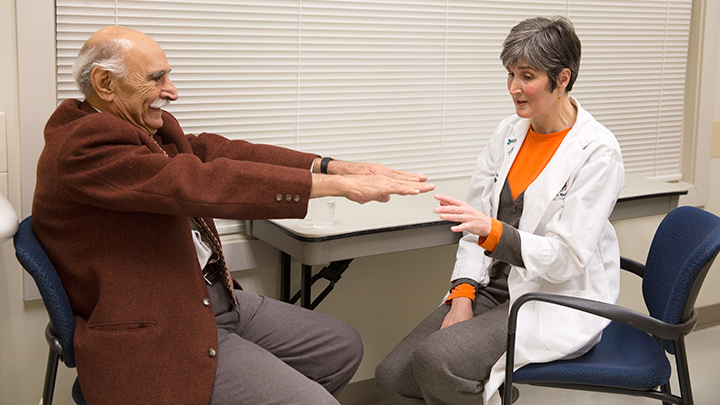
February 20, 2018

Dr. Zelma Kiss, AHS neurosurgeon and University of Calgary professor, admires the newly steady hands of her patient Elias Pharaon. The 85-year-old suffers from a movement disorder called ‘essential tremor’ and recently benefited from technology that allowed surgeons to access his brain using magnetic resonance-guided and focused ultrasound. Kiss is part of the team that developed this new approach to brain surgery.
Story by Kelly Johnston & Gregory Kennedy | Photo by Riley Brandt/University of Calgary
Instant results and no scar. These are words one rarely associates with brain surgery — until now.
Fresh research and new technology that uses magnetic resonance to guide and focus ultrasound with laser precision are giving Alberta Health Services (AHS) neurosurgeons the ability to instantly calm certain severe tremors and restore quality of life to patients for whom medication is not the answer.
“We are able to see the brain with real-time imaging and target a beam of high-intensity ultrasound to the brain region responsible for tremor,” says Dr. Zelma Kiss, AHS neurosurgeon and University of Calgary professor in the departments of Clinical Neurosciences and Psychiatry at the Cumming School of Medicine (CSM). “The patient is awake the whole time and the results are immediate.”
Just ask Elias Pharaon. Thanks to this new style of brain surgery, the 85-year-old can now sign his name for the first time in five years.
“I couldn’t believe the tremor in my right hand was gone. I didn’t feel anything during the procedure,” says Pharaon. “I was so happy. It’s changed my life, I feel like I can go out in public again.”
Pharaon came from B.C. and volunteered to undergo this procedure at Foothills Medical Centre in Calgary and participate in the research project last fall.
Essential tremor is usually treated with medication, but for some, like Pharaon, the medication doesn’t work and the tremors become so severe people can no longer dress or feed themselves.
“Essential tremor is a neurological disorder. It’s the most common of all the movement disorders,” says Kiss. “However, not that many people have it so severely that it disables them from doing everything.
“It means that somebody can’t sign their name. It means that they can’t bring a cup of coffee to their mouth. Elias has a severe form of essential tremor and is disabled by it. That’s why he was referred for the high-intensity, focused-ultrasound treatment.”
Dr. Davide Martino, movement disorder specialist and associate professor in the Department of Clinical Neurosciences at CSM, concurs, adding, “The condition occurs because different parts of the brain are not talking to each other properly, and the abnormal network function causes the tremor to appear.”
Performed by a team of University of Calgary physicians and researchers with the Hotchkiss Brain Institute, the new magnetic resonance-guided focused ultrasound (MRgFUS) technology allows surgeons to access the brain without cutting the skin, or drilling into the skull. The CSM MRgFUS system is the only one of its kind in western Canada.
Martino will identify patients who qualify for treatment, and conduct all the followup work for the research study which will include brain scans, clinical evaluations, cognitive and functional testing, and motor and sensory abilities over time.
“This is the beginning of a much larger research platform,” says Bruce Pike, PhD, professor in the departments of Radiology and Clinical Neurosciences at CSM. “The idea of neurosurgery in an awake patient without breaking the skin is revolutionary. With the use of this technology we are looking at different treatment options for a number of devastating brain diseases such as Parkinson’s disease, dementia, epilepsy and brain tumours.”
And the technology has positive ramifications for the future of healthcare.
“This is a wonderful example of precision health research,” says Dr. Jon Meddings, dean, CSM. “The future of health is accurately diagnosing and providing individualized treatments to our patients. The remarkable results of the MRgFUS program show how new technologies can make precision health a reality.”
The ongoing research study is being done in collaboration with Alberta Health Services and with funding from Canada Foundation for Innovation and private donors, including significant donations from the Rob McAlpine Legacy Initiative and the Cumming Medical Research Fund.
At this point, only patients with severe medication-resistant essential tremor are being treated with MRgFUS.
“Really, to see them come in, lie in the MRI scanner and two hours later get up, walk out, take a drink of water and sign their name — it’s impressive,” says Pike. “It really is life-changing for them. And, yeah, that’s extremely gratifying.”
Hear Dr. Kiss explain her new style of brain surgery in video.